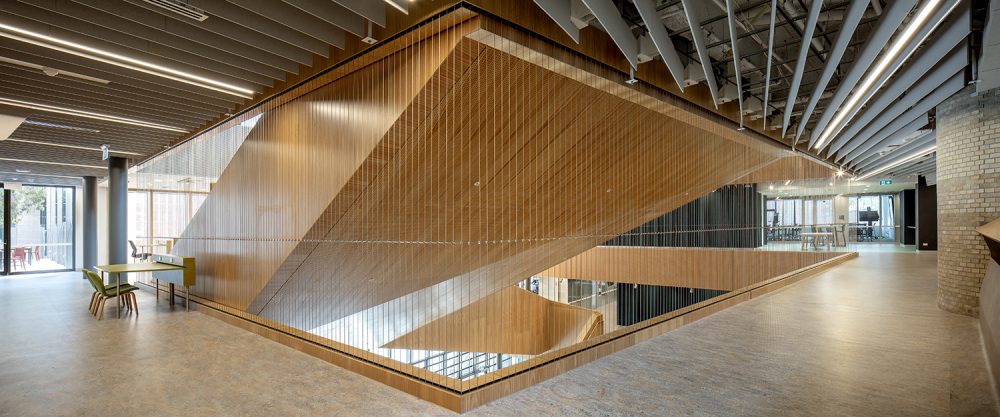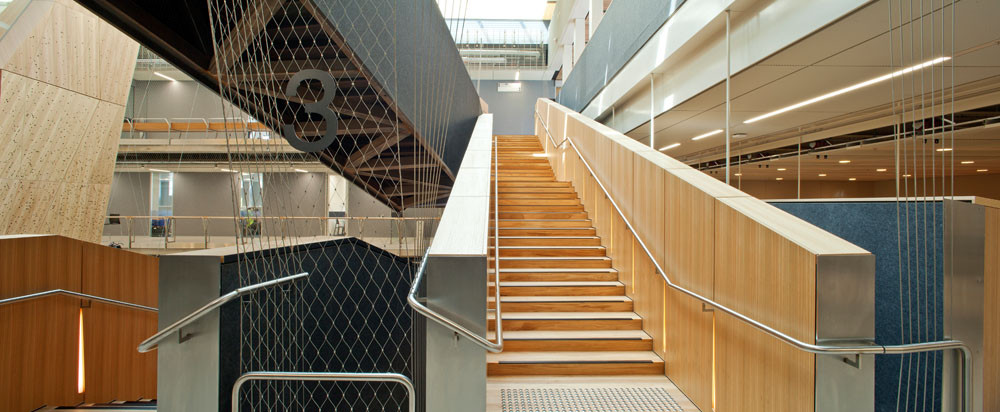Transparent safety barriers are growing in popularity as they fit well with modern open design that seeks to create connection points between floor levels.
Heavy or closed barriers on the other hand might provide safety, but they tend to block natural light and airflow. They can also interfere with design – especially where the aim is for good internal flow and unity.
Transparent barriers are commonly used on mezzanines and atriums, such as in shopping centres, office buildings, and educational institutions. Glass is often used due to its transparency and lifespan (approximately ten years) and relative ease of installation.
However, as a commercial balustrade material, glass can have some drawbacks:
- Some of its transparency can be lost when dirty or smudged, or when the light bounces off the surface.
- Being a solid material, it lacks flexibility and may be limited to installations with regular, uniform shapes.
- Tends to be a heavy material to carry and install, especially where high load requirements need to be met.
- Can be expensive when it comes to making it resistant to heat and fire.
Another drawback is that to make a glass barrier non-climbable, the panels must be at least 1.2m in height. This can interfere with air conditioning systems and add to installation costs.
If larger panels of this size are not used, it means that the full space of the upper level or levels can’t be utilised. This is because all furniture and other items must be placed at least one metre from the edge to prevent climbing.

Stainless steel cables for transparent safety barriers
Stainless steel wire cables are an alternative solution, as they offer the benefits of transparency and safety, without many of the problems associated with glass.
For example, compared to glass, wire cable and mesh can offer the following benefits:
- Flexibility, which makes these materials great for oddly-shaped or non-uniform installations.
- Lightweight, quick installation with no need for sub-frame.
- Very low requirements for ongoing maintenance and cleaning.
- High fire-resistance.
- Can accommodate large spans – ideal for installation over several storeys.
- Great longevity – up to 25 years.
- Easy to make non-climbable through full-height installation.
Projects using transparent safety barriers
A vertical 5mm stainless steel cable barrier was installed on the atrium at the new Conservatorium of Music centre in Southbank, coloured black to blend in with the building design.
Wire cables were ideal for this project, as the atrium changes shape at various points, meaning that the barrier needed to be able to adapt.
Being full-height over the three levels of the atrium also makes the barrier fully non-climbable, and prevents items being dropped or thrown over the edge.
At the same time, the barrier is very transparent which facilitates visual connection points and allows for natural light and airflow.
This approach was also used at the Monash Learning and Teaching Building to create a full-use atrium over all three levels of the space. At the Melbourne School of Design, Webnet mesh was used for the barrier across all five levels of the atrium, providing robust safety, longevity and transparency.
To find out more about transparent safety barriers for commercial, industrial or educational buildings, feel free to get in touch with us.






































